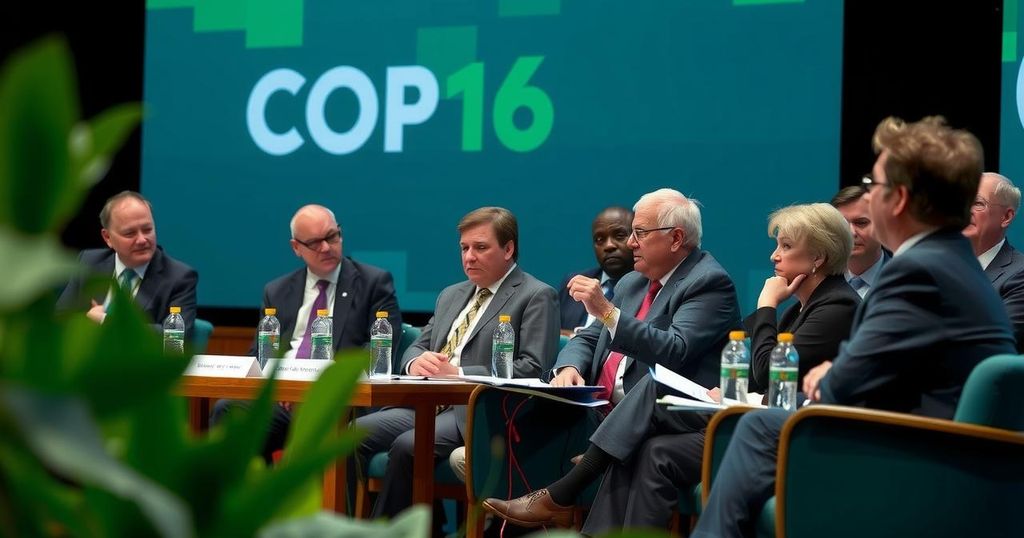As nearly 200 nations gather for COP16 in Cali, Colombia, discussions will focus on combining climate change efforts with biodiversity goals. The summit seeks to establish a unified pledge that recognizes the correlation between safeguarding nature and combating climate change. Alarmingly, statistics show a significant portion of species is facing extinction, and unprecedented climate events highlight the need for immediate action. Experts call for synergy among existing environmental conventions and increased funding to support developing countries in their efforts to meet these challenges.
Delegates from nearly 200 countries are convening in Cali, Colombia, for the 16th Conference of the Parties (COP16), a two-week United Nations biodiversity summit aimed at establishing a cohesive approach for integrating global nature and climate objectives. Historically, nations have treated climate change and biodiversity as separate issues; however, there is a growing recognition of their interconnectedness. Protecting biodiversity is essential in combating climate change, while climate change adversely affects biodiversity and accelerates species extinction rates. The urgency for action is emphasized by the alarming statistics on biodiversity loss: approximately 25% of known species, totaling around 45,300, are currently at risk of extinction. Furthermore, the world is witnessing unprecedented events of coral reef bleaching due to rising ocean temperatures, with 77% of coral territories exhibiting heat stress. The COP16 summit comes in the aftermath of a significant loss of old-growth forests, with nearly 37,000 square kilometers—an area nearly equivalent to Switzerland—lost in the previous year. Notably, Canada experienced an extraordinary spike in wildfire occurrences, destroying over 80,000 square kilometers of forest, releasing 647 megatonnes of carbon emissions, thereby exacerbating climate change. Colombia’s Environment Minister, Susana Muhamad, underscored the necessity of a unified climate and biodiversity pledge. She articulated, “We really think that taking care of nature, reconnecting to nature, and conserving together… will make us more resilient to climate change shocks that will also create more broader context for conflict.” The summit will highlight the need for synergy among the three current UN environmental conventions to streamline efforts in combating climate change, biodiversity loss, and desertification. Such an integrated strategy could reduce the administrative burdens faced by developing nations that struggle with resource scarcity. There is also a pressing need for countries to adhere to commitments made in the Kunming-Montreal Global Biodiversity Framework agreement, which parallels the objectives of the Paris Agreement for climate change. “COP16 is an opportunity to re-energize and remind everybody of their commitments… if we are going to get anywhere close to 2030 targets being achieved,” stated Gavin Edwards of Nature Positive. Additionally, COP16 will address further measures for sustainable funding mechanisms to aid biodiversity efforts, particularly for developing countries. Despite emerging commitments, experts caution that current funding levels fall substantially short of the estimated $542 billion required annually by 2030 to avert nature loss and achieve climate objectives.
The upcoming COP16 summit is a pivotal moment for global leaders to reshape the narrative around climate change and biodiversity. Historically, the two areas of concern have been treated in isolation, hindering effective action. However, the growing recognition of their interlinkages compels nations to create synergies in policy-making. The summit aims to unify actions across existing environmental frameworks while acknowledging the critical role of biodiversity in climate resilience. Furthermore, unique opportunities to bolster funding and support mechanisms for developing regions will be explored, aiming to reduce the socioeconomic disparities exacerbated by environmental degradation.
In conclusion, COP16 presents a vital opportunity for stakeholders from nearly 200 nations to converge on the imperative need to align climate change and biodiversity agendas. The session stresses the importance of integrating strategies to safeguard both nature and climate while addressing the challenges posed by inadequate funding and governmental commitments. The rising existential threat to biodiversity underscores the urgency of unified action to foster a sustainable and resilient future for future generations.
Original Source: www.asiafinancial.com







